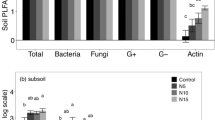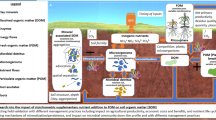Abstract
Addition of single species of soil animals to animal-free microcosms often increases total heterotrophic respiration, but sometimes additions of microarthropods have been reported not to increase or even decrease CO2 evolution rates. Most studies indicate that addition of soil animals increases net N mineralisation. In a study with F/H layer materials from a spruce stand in central Sweden kept at two temperatures (5 and 15°C) and three moisture levels (15, 30 and 60% of WHC), addition of a mixed fauna of soil arthropods, mainly microarthropods, could not be shown to change the CO2 evolution rates in comparison with materials where arthropods were absent. However, addition of the arthropods significantly increased net N mineralisation for each of the temperature and moisture combinations. The increase due to the arthropods was dependent on soil temperature but not on soil moisture. Because the total net N mineralisation decreased with decreasing soil moisture, the soil arthropods had a much larger relative effect on net N mineralisation under dry than under moist conditions. It is concluded that soil arthropods are important in maintaining net N mineralisation under dry conditions when the microflora is largely inactive. The microbial/faunal release of mineral N is discussed in relation to the C∶N of the substrate.
Similar content being viewed by others
References
Anderson J M, Ineson P and Huish S A 1983 Nitrogen and cation mobilization by soil fauna feeding on leaf litter and soil organic matter from deciduous woodlands. Soil Biol. Biochem. 15, 463–467.
Andrén O and Schnürer J 1985 Barley straw decomposition with varied levels of microbial grazing byFolsomia fimetaria (L.) (Collembola, Isotomidae). Oecologia (Berlin) 68, 57–62.
Axelsson B, Lohm U and Persson T 1984 Enchytraeids, lumbricids and soil arthropods in a northern deciduous woodland—a quantitative study. Holarct. Ecol. 7, 91–103.
Bevan W J 1962 Observations on damage to grassland in East Yorkshire by larvae of the common leaf weevil,Phyllobius pyri L. and notes on its biology. J. Brit. Grassl. Soc. 17, 194–197.
Clarholm M 1985 Interactions of bacteria, protozoa and plants leading to mineralization of soil nitrogen. Soil Biol. Biochem. 17, 181–187.
Coleman D C, Anderson R V, Cole C V, Elliott E T, Woods L and Campion M K 1978 Trophic interactions in soils as they affect energy and nutrient dynamics. IV. Flows of metabolic and biomass carbon. Microbial Ecology 4, 373–380.
Coleman D C, Sasson A, Breymeyer A I, Dash M C, Dommergues Y, Hunt H W, Paul E A, Schaefer R, Ulehlová B and Zlotin R I 1980 Decomposer subsystem.In Grasslands, Systems Analysis and Man. Eds. A I Breymeyer and G M Van Dyne. International Biological Programme 19, pp. 609–655. Cambridge University Press, Cambridge.
Coleman D C, Reid C P P and Cole C V 1983 Biological strategies of nutrient cycling in soil systems. Adv. Ecol. Res. 13, 1–55.
Coulson J C and Whittaker J B 1978 Ecology of moorland animals.In Production Ecology of British Moors and Montane Grasslands. Eds. O W Heal and D F Perkins. Ecol. Stud. 27, 52–93. Springer-Verlag, Berlin.
Ellenberg H, Mayer R and Schauermann J 1986 Ökosystemforschung —Ergebnisse des Sollingprojekts 1966–1986. Ulmer, Stuttgart, 507 pp
Griffiths B S 1986 Mineralization of nitrogen and phosphorus by mixed cultures of the ciliate protozoanColpoda steinii, the nematodeRhabditis sp. and the bacteriumPseudomonas fluorescens. Soil Biol. Biochem. 18, 637–641.
Hanlon R D G and Anderson J M 1979 The effects of collembola grazing on microbial activity in decomposing leaf litter. Oecologia (Berl.) 38, 93–99.
Hanlon R D G and Anderson J M 1980 Influence of macroarthropod feeding activities on microflora in decomposing oak leaves. Soil Biol. Biochem. 12, 255–261.
Huhta V and Koskenniemi A 1975 Numbers, biomass and community respiration of soil invertebrates in spruce forests at two latitudes in Finland. Ann. Zool. Fennici 12, 164–182.
Ineson P, Leonard M A and Anderson J M 1982 Effect of collembolan grazing upon nitrogen and cation leaching from decomposing leaf litter. Soil Biol. Biochem. 14, 601–605.
Jansson P E 1977 Soil properties at Ivantjärnsheden. Swed. Conif. For. Proj., Int. Rep. 54, 66 pp.
Kitazawa Y 1971 Biological regionality of the soil fauna and its function in forest ecosystem types.In Productivity of Forest Ecosystems. Ed. P Duvigneaud. Proc. Brussels Symp. 1969, pp 485–498. Unesco, Paris.
Persson T 1983 Influence of soil animals on nitrogen mineralisation in a northern Scots pine forest.In New Trends in Soil Biology. Eds. Ph Lebrunet al. Proc. 8th Int. Coll. Soil Zool., pp. 117–126.
Persson T and Lohm U 1977 Energetical significance of the annelids and arthropods in a Swedish grassland soil. Ecol. Bull. (Stockholm) 23, 1–211.
Persson, T, Bååth E, Clarholm M, Lundkvist H, Söderström B E and Sohlenius B 1980 Trophic structure, biomass dynamics and carbon metabolism of soil organisms in a Scots pine forest.In Structure and Function of Northern Coniferous Forests — An Ecosystem Study. Ed. T. Persson. Ecol. Bull. (Stockholm) 32, 419–459.
Reichle D E 1977 The role of soil invertebrates in nutrient cycling.In Soil Organisms as Components of Ecosystems. Eds U Lohm and T Persson. Proc. 6th Int. Coll. Soil Zool., Ecol. Bull. (Stockholm) 25, 145–156.
Salt G and Hollick F S J 1944 Studies of wireworm populations. I. A census of wireworms in pasture. Ann. Appl. Biol., 31, 52–64.
Satchell J E 1971 Feasibility study of an energy budget for Meathop Wood.In Productivity of Forest Ecosystems. Ed. P. Duvigneaud. Proc. Brussels Symp. 1969, pp 619–630.
Seastedt T R 1984 The role of microarthropods in decomposition and mineralization processes. Ann. Rev. Entomol. 29, 25–46.
Setälä H, Haimi J and Huhta V 1988 A microcosm study on the respiration and weight loss in birch litter and raw humus as influenced by soil fauna. Biol. Fertil. Soils 5, 282–287.
Standen V 1978 The influence of soil fauna on decomposition by micro-organisms in blanket bog litter. J. Anim. Ecol. 47, 25–38.
Woods L E, Cole C V, Elliott E T, Anderson R V and Coleman D C 1982 Nitrogen transformations in soil as affected by bacterial-microfaunal interactions. Soil Biol. Biochem. 14, 93–98.
Zlotin R I and Khodashova K S 1980 The role of animals in biological cycling of forest-steppe ecosystems. Dowden, Hutchinson & Ross, Stroudsburg, 221 p.
Author information
Authors and Affiliations
Rights and permissions
About this article
Cite this article
Persson, T. Role of soil animals in C and N mineralisation. Plant Soil 115, 241–245 (1989). https://doi.org/10.1007/BF02202592
Issue Date:
DOI: https://doi.org/10.1007/BF02202592




